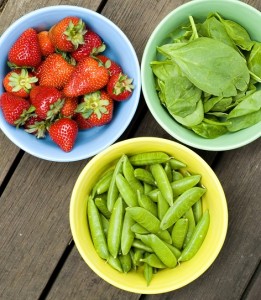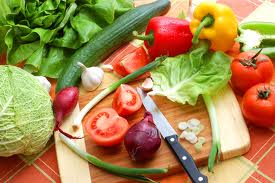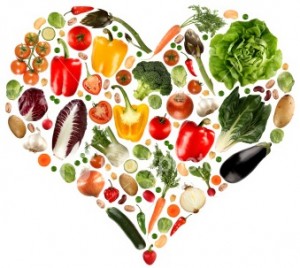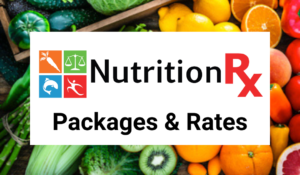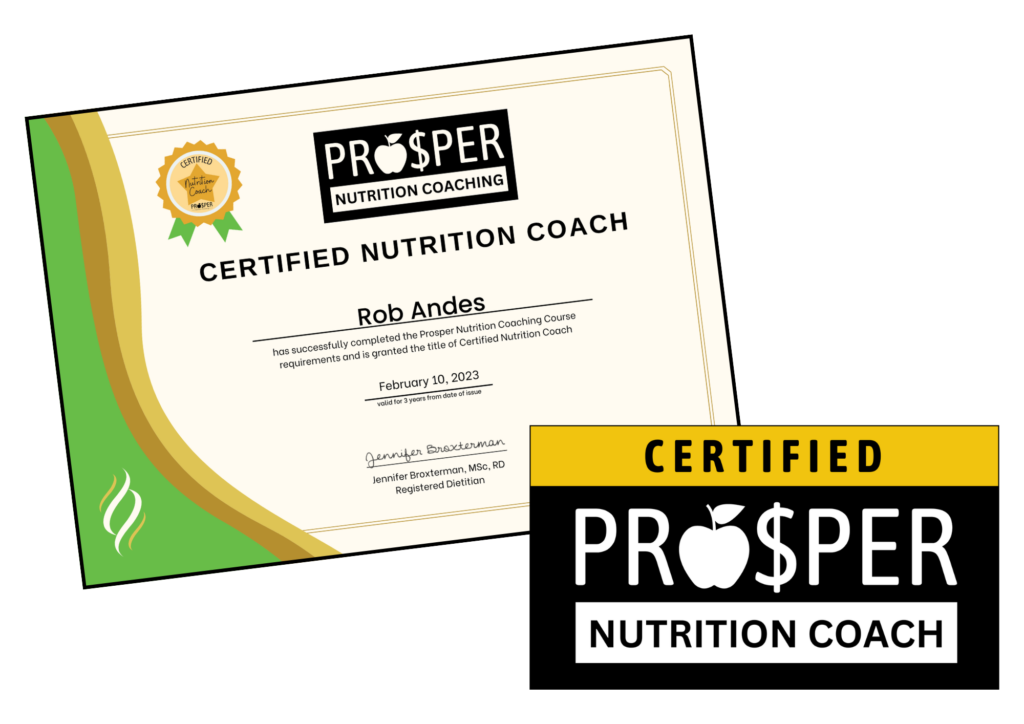

Vegetables & Fruit: 6 Tips for Optimal Health & Weight Loss
Written By: Jennifer Broxterman, Registered Dietitian & Sports Nutritionist
NutritionRx | www.nutritionrx.ca
Offering professional nutrition counselling services in London, Ontario.
Email: info@nutritionrx.ca
Although nutrition messages are often conflicting, there’s one area where most experts do agree: eating more vegetables and fruit each day is a good thing to prevent chronic disease, maintain a healthy weight, and look and feel our best. This is also pretty obvious to the average person, but sometimes knowing what to do, and actually doing it, isn’t always as closely connected as we would like. Here are some simple nutrition strategies to help you increase your intake of vegetables and fruit and make it a lasting lifestyle change.
1. KNOW YOUR NUMBERS.
Start off by understanding how much you should be eating each day for proper health, and what a serving size looks like.
Recommended # of Vegetable & Fruit Food Guide Servings per Day:
| Age | Females | Males |
| 2-3 | 4 | 4 |
| 4-8 | 5 | 5 |
| 9-13 | 6 | 6 |
| 14-18 | 7 | 8 |
| 19-50 | 7-8 | 8-10 |
| 51+ | 7 | 7 |
What Does a Canada’s Food Guide Servings Look Like?
- Fresh, frozen, or canned vegetables: ½ cup (125 mL)
- Cooked leafy vegetables: ½ cup (125 mL)
- Raw leafy vegetables: 1 cup (250 mL)
- Fresh, frozen, or canned fruit: 1 medium fruit or ½ cup (125 mL)
- Dried fruit: ¼ cup (63 mL)
- 100% juice: ½ cup (125 mL)
Aim for 1-2 servings at every meal.
2. PREPARE A WEEKLY “VEGGIE BUCKET”.
This is one of my all-time favourite strategies to help people increase their intake of vegetables. After grocery shopping, make it a weekly priority to wash and cut up all of the vegetables you plan to eat over the next week, then place in a large, clear glass container on an easy-to-reach shelf in your refrigerator. This single habit helps prevent food from going to waste in the crisper drawer, and always gives you an easy-to-grab option when packing veggies in your lunch, as an after-work or after-school snack, or to toss into a stir-fry or put alongside whatever dinner you have planned. Some of my favourite “veggie bucket” items include: baby carrots, cucumber slices, bell pepper strips, celery stalks, diced purple cabbage, cherry tomatoes, snow peas, green beans, sugar snap peas, broccoli and cauliflower florets, zucchini slices or strips (they actually taste pretty good raw!), and whatever else your heart desires. It’s actually incredible to see how many more veggies you and your family members will eat when healthy options are prepared in advance and are easy to access. Like I said, this is the single best habit to adopt!
3. FOLLOW THE “HEALTHY PLATE” METHOD.
Basically this means adopting a dinner plate that is 50% vegetables (aim for 2 different colours or 2 different kinds of veggies at one meal), 25% protein (lean meats, poultry, fish, beans/legumes), 25% starch (whole grains like rice, pasta, bread, quinoa and starchy veggies like potatoes, corn, peas, or squash). Feel free to add a source of calcium (like a glass of milk, low-fat yogurt, or cheese) and piece of fruit to complete your meal.
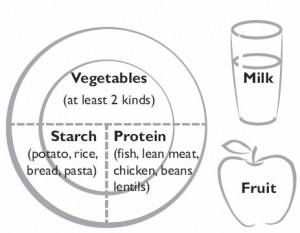
4. COLOUR IT UP!
All vegetables and fruit offer an abundance of nutrients such as fibre, vitamins A, C, K, calcium, iron, potassium, antioxidants, phytochemicals, and more, without the high-calorie/high-sodium price tag of other foods. The goal here is to try to maximize which nutrients your body receives by eating from all colours of the rainbow: RED, ORANGE, YELLOW, GREEN, BLUE/PURPLE, and WHITE. While grocery shopping, if you can select a fruit or vegetable item from each of those 6 colour categories, you’re doing well! Extra points if you eat both a dark green and a bright orange vegetable each day of the week.
5. VARIETY IS GOOD.
Take a moment and reflect on the vegetables and fruit you’ve consumed over the past 3 months. If your list consists of the same items again and again (think: bananas, apples, carrots, onions, tomatoes, etc.), it’s time to shake things up.
From the list below, make a mental note of any items that it’s been more than 4 weeks since you last ate it, and make an effort to try something new from each of the different colour group below:
Red: apples, beets, cherries, cranberries, grapes, guava, papaya, grapefruit, pomegranates, radicchio, radishes, raspberries, red bell peppers, red chilli pepper, red onions, red potatoes, rhubarb, strawberries, tomatoes, watermelon
Orange: apricots, cantaloupe, cape gooseberries, carrots, mangoes, nectarines, oranges, peaches, pumpkin, rutabagas, squash, sweet potatoes, tangerines
Yellow: bananas, corn, lemons, pineapples, plantains, starfruit, yellow bell peppers, yellow kiwi, yellow wax beans
Green: artichokes, arugula, asparagus, avocados, bok choy, broccoli, Brussels sprouts, celery, Chinese cabbage, cucumbers, granny smith apples, grapes, green beans, green bell peppers, green cabbage, green onion, honeydew melon, iceberg lettuce, kale, kiwi, limes, okra, peas, Romaine lettuce, snow peas, spinach, sugar snap peas, zucchini
Blue/Purple: black currants, blackberries, blueberries, dried plums (prunes), eggplant, elderberries, grapes, plums, purple cabbage, figs, raisins
White: cauliflower, garlic, mushrooms, onions, pears, parsnips, potatoes, turnips
6. INCLUDE A FRUIT OR VEGETABLE WITH EACH MEAL.
If you wait until dinner to have your first vegetable of the day, you’ll likely have trouble eating enough to fulfill your daily requirement. Start off by committing to have a piece of fruit with your breakfast each morning. Try to eat a whole piece of fruit versus drinking fruit juice, which offers more fibre, and fewer calories and grams of sugar. At lunch, commit to at least 1 serving (½ cup) of vegetables with your meal… here’s where that “veggie bucket” comes in really handy to efficiently help you pack a healthy lunch every day. Finally, at dinner, apply the “Healthy Plate” method and try your best to cover 50% of your plate with vegetables, which naturally works out to a minimum of 2-3 vegetable servings (1-1.5 cups). Look to get your remaining servings by having pieces of fresh fruit for snacks throughout the day.
Wishing you health & happiness,
♡ Jen
Jennifer Broxterman, MSc, RD
Registered Dietitian
NutritionRx: happy, healthy living with our team of Registered Dietitians
Prosper Nutrition Coaching: a world-class nutrition coaching certification
+
+
+
Want to work with a NutritionRx Registered Dietitian?
Learn more here: Nutrition Packages & Rates
+
+
+
Want to become a Certified Nutrition Coach?
Learn more about our habits-based Prosper Nutrition Certification

